Manure Application Timing and Tillage Influence on Nutrient Loss from Snowmelt Runoff
Abstract
:1. Introduction
- Determine the contributions of manure nutrients and snowmelt hydrology (soil moisture and temperature) to snowmelt runoff and nutrient loss.
- Compare the effect of prior fall tillage and untilled fields on nutrient losses from subsequent manure applications.
- Determine the influence of winter manure application timing (manure application before snow vs. manure applications on snow) on nutrient losses.
2. Materials and Methods
2.1. Experimental Design
2.2. Data Collection
2.3. Statistical Analyses
3. Results and Discussion
3.1. Hydrologic Processes and Temperatures
3.2. Tillage-Affected Runoff and Nutrient Loss
4. Conclusions
Author Contributions
Funding
Institutional Review Board Statement
Informed Consent Statement
Data Availability Statement
Acknowledgments
Conflicts of Interest
References
- Shuyler, L.; Meek, J.W. EPA guidelines concerning agricultural manure management practices. In Dairy Manure Management; Cornell University: Ithaca, NY, USA, 1989; pp. 23–28. [Google Scholar]
- McDowell, R.W.; Biggs, B.J.F.; Sharpley, A.N.; Nguyen, L. Connecting phosphorus loss from agricultural landscapes to surface water quality. Chem. Ecol. 2004, 20, 1–40. [Google Scholar] [CrossRef]
- Smith, D.; Owens, P.; Leytem, A.; Warnemuende, E. Nutrient losses from manure and fertilizer applications as impacted by time to first runoff event. Environ. Pollut. 2007, 147, 131–137. [Google Scholar] [CrossRef] [PubMed]
- Srinivasan, S.M.; Bryant, R.B.; Callahan, M.P.; Weld, J.L. Manure management and nutrient loss under winter conditions: A literature review. J. Soil Water Conserv. 2006, 61, 200–206. [Google Scholar]
- Meals, D.W. Watershed-scale response to agricultural diffuse pollution control programs in Vermont, USA. Water Sci. Technol. 1996, 33, 197–204. [Google Scholar] [CrossRef]
- Miller, J.J.; Chanasyk, D.S.; Curtis, T.W.; Olson, B.M. Phosphorus and nitrogen in runoff after phosphorus- or nitrogen-based manure applications. J. Environ. Qual. 2011, 40, 949–958. [Google Scholar] [CrossRef]
- Sharpley, A.N. Dependence of Runoff Phosphorus on Extractable Soil Phosphorus. J. Environ. Qual. 1995, 24, 920–926. [Google Scholar] [CrossRef] [Green Version]
- Goolsby, D.A.; Battaglin, W.A.; Lawrence, G.B.; Artz, R.S.; Aulnbach, B.T.; Hooper, R.P.; Keeney, D.R.; Stensland, G.J. Flux and sources of nutrients in Mississippi Atchafalaya river basin: Topic 3 Report for the Integrated Assessment on Hypoxia in the Gulfof Mexico. In NOAA Coastal Ocean Program Decision Analysis Series; NOAA: Silver Spring, MD, USA, 1999; p. 130. [Google Scholar]
- Carpenter, S.R.; Caraco, N.F.; Correll, D.L.; Howarth, R.W.; Sharpley, A.N.; Smith, V.H. Nonpoint pollution of surface waters with phosphorus and nitrogen. Ecol. Soc. Am. 1998, 8, 559–568. [Google Scholar] [CrossRef]
- USEPA. Preventing Eutrophication: Scientific Support for Dual Nutrient Criteria; EPA 820-S015-001; USEPA: Washington, DC, USA, 2015.
- Formanek, G.E.; Muckel, G.B.; Evans, W.R. Conservation applications impacted by soil freeze-thaw. In Frozen Soil Impacts on Agricultural Range and Forest Lands, Proceedings of the International Symposium, Sponkane, WA, USA, 21–22 Marah 1990; Cooly, K.R., Ed.; CRREL Special Report 90-1; US. Army Cold Regions Research and Engineering Laboratory: Hanover, NH, USA, 1990; pp. 108–112. [Google Scholar]
- Liu, J.; Kleinman, P.J.A.; Aronsson, H.; Flaten, D.; McDowell, R.W.; Bechmann, M.; Beegle, D.B.; Robinson, T.P.; Bryant, R.B.; Liu, H.; et al. A Review of Regulations and Guidelines Related to Winter Manure Application. Ambio 2018, 47, 657–670. [Google Scholar] [CrossRef] [PubMed]
- Fleming, R.; Fraser, H. Impacts of Winter Spreading of Manure on Water Quality: Literature Review; Ridgetown College, University of Guelph: Ridgetown, ON, Canada, 2000; Available online: https://www.farmfoodcareon.org/wp-content/uploads/2019/02/Impacts-of-winter-spreading-on-water-quality.pdf (accessed on 20 August 2021).
- Liu, J.; Veith, T.L.; Collick, A.S.; Kleinman, P.J.A.; Beegle, D.B.; Bryant, R.B. Seasonal Manure Application Timing and Storage Effects on Field- and Watershed-Level Phosphorus Losses. J. Environ. Qual. 2017, 46, 1403–1412. [Google Scholar] [CrossRef] [PubMed]
- Liu, K.; Elliott, J.A.; Lobb, D.A.; Flaten, D.N.; Yarotski, J. Conversion of Conservation Tillage to Rotational Tillage to Reduce Phosphorus Losses during Snowmelt Runoff in the Canadian Prairies. J. Environ. Qual. 2014, 43, 1679–1689. [Google Scholar] [CrossRef] [PubMed]
- Liu, K.; Elliott, J.A.; Lobb, D.A.; Flaten, D.N.; Yarotski, J. Nutrient and Sediment Losses in Snowmelt Runoff from Perennial Forage and Annual Cropland in the Canadian Prairies. J. Environ. Qual. 2014, 43, 1644–1655. [Google Scholar] [CrossRef] [PubMed]
- Schneider, K.D.; McConkey, B.G.; Thiagarajan, A.; Elliott, J.A.; Reid, D.K. Nutrient Loss in Snowmelt Runoff: Results from a Long-term Study in a Dryland Cropping System. J. Environ. Qual. 2019, 48, 831–840. [Google Scholar] [CrossRef] [PubMed] [Green Version]
- Hansen, N.C.; Daniel, T.C.; Sharpley, A.N.; Lemunyon, J.L. The fate and transport of phosphorus in agricultural systems. J. Soil Water Conserv. 2002, 57, 408–417. [Google Scholar]
- Young, R.A.; Mutchler, C.K. Pollution Potential of Manure Spread on Frozen Ground. J. Environ. Qual. 1976, 5, 174–179. [Google Scholar] [CrossRef]
- Ismail, I.; Blevins, R.L.; Frye, W.W. Long-Term No-tillage Effects on Soil Properties and Continuous Corn Yields. Soil Sci. Soc. Am. J. 1994, 58, 193–198. [Google Scholar] [CrossRef]
- Ranaivoson, A.; Moncrief, J.; Hansen, N.; Gupta, S. Effect of fall tillage following soybeans on organic matter losses in snowmelt. Soil Tillage Res. 2005, 81, 205–216. [Google Scholar] [CrossRef]
- Vadas, P.A.; Stock, M.N.; Feyereisen, G.W.; Arriaga, F.J.; Good, L.W.; Karthikeyan, K.G. Temperature and Manure Placement in a Snowpack Affect Nutrient Release from Dairy Manure during Snowmelt. J. Environ. Qual. 2018, 47, 848–855. [Google Scholar] [CrossRef] [PubMed] [Green Version]
- Eghball, B.; Gilley, J.E. Phosphorus and Nitrogen in Runoff following Beef Cattle Manure or Compost Application. J. Environ. Qual. 1999, 28, 1201–1210. [Google Scholar] [CrossRef]
- Little, J.L.; Bennett, D.R.; Miller, J.J. Nutrient and Sediment Losses Under Simulated Rainfall Following Manure Incorporation by Different Methods. J. Environ. Qual. 2005, 34, 1883–1895. [Google Scholar] [CrossRef] [PubMed] [Green Version]
- Mueller, D.H.; Wendt, R.C.; Daniel, T.C. Soil and Water Losses as Affected by Tillage and Manure Application. Soil Sci. Soc. Am. J. 1984, 48, 896–900. [Google Scholar] [CrossRef]
- Young, A.R.; Holt, R.F. Winter applied manure: Effects on annual runoff, erosion, and nutrient movement. J. Soil Water Conserv. 1977, 35, 219–222. [Google Scholar]
- Van Vliet, L.J.P.; Hall, J.W. Effects of two crop rotations on seasonal runoff and soil loss in the Peace River region. Can. J. Soil Sci. 1991, 71, 533–543. [Google Scholar] [CrossRef] [Green Version]
- Xu, J.; Li, H.; Liu, X.; Hu, W.; Yang, Q.; Hao, Y.; Zhen, H.; Zhang, X. Gully Erosion Induced by Snowmelt in Northeast China: A Case Study. Sustainability 2019, 11, 2088. [Google Scholar] [CrossRef] [Green Version]
- Komissarov, M.A.; Gabbasova, I.M. Snowmelt-induced soil erosion on gentle slopes in the southern Cis-Ural region. Eurasian Soil Sci. 2014, 47, 598–607. [Google Scholar] [CrossRef]
- Singh, S.; Brandenburg, N.; Ahiablame, L.; Gongalez, A.; Kjaersgaard, J.; Trooien, T.P.; Kumar, S. Response of winter manure application on surface runoff water quantity and quality from small watersheds in South Dakota. Water Air Soil Pollut. 2017, 228, 389. [Google Scholar] [CrossRef]
- Hensler, R.F.; Olsen, R.J.; Witzel, S.A.; Attoe, O.J.; Paulson, W.H.; Johannes, R.F. Effect of Method of Manure Handling on Crop Yields, Nutrient Recovery and Runoff Losses. Trans. ASAE 1970, 13, 726–731. [Google Scholar] [CrossRef]
- Minshall, N.E.; Witze, S.A.; Nicholas, M.S. Stream enrichment from farm operations. J. Sanit. Eng. Div. 1970, 96, 513–524. [Google Scholar] [CrossRef]
- Klausner, S.D.; Zwerman, P.J.; Ellis, D.F. Nitrogen and Phosphorus Losses from Winter Disposal of Dairy Manure. J. Environ. Qual. 1976, 5, 47–49. [Google Scholar] [CrossRef]
- Lorimor, J.C.; Melvin, J.C. Nitrogen Losses in Surface Runoff from Winter Applied Manure; Final Report; University of Iowa: Iowa City, IA, USA, 1996. [Google Scholar]
- Midgley, A.R.; Dunklee, D.E. Fertility Runoff Losses from Manure Spread during the Winter; Agricultural Experiment Station, University of Vermont and State Agricultural College: Burlington, VT, USA, 1945; Volume 523, pp. 1–19. [Google Scholar]
- Zuzel, J.F.; Pikul, J.L., Jr. Infiltration into a seasonally frozen agricultural soil. J. Soil Water Conserv. 1987, 42, 447–450. [Google Scholar]
- Owens, L.B.; Bonta, J.V.; Shipitalo, M.; Rogers, S. Effects of Winter Manure Application in Ohio on the Quality of Surface Runoff. J. Environ. Qual. 2011, 40, 153–165. [Google Scholar] [CrossRef]
- Kongoli, C.E.; Bland, W.L. Influence of manure application and surface energy and snow cover: Field experiments. J. Environ. Qual. 2002, 31, 1166–1173. [Google Scholar] [CrossRef]
- Stock, M.N.; Arriaga, F.J.; Vadas, P.A.; Good, L.W.; Casler, M.D.; Karthikeyan, K.G.; Zopp, Z. Fall Tillage Reduced Nutrient Loads from Liquid Manure Application during the Freezing Season. J. Environ. Qual. 2019, 48, 889–898. [Google Scholar] [CrossRef] [PubMed] [Green Version]
- Olsen, S.R. Estimation of Available Phosphorus in Soils by Extraction with Sodium Bicarbonate; USDA: Washington, DC, USA, 1954.
- Gee, G.W.; Bauder, J.W. Particle Size Analysis by Hydrometer: A Simplified Method for Routine Textural Analysis and a Sensitivity Test of Measurement Parameters. Soil Sci. Soc. Am. J. 1979, 43, 1004–1007. [Google Scholar] [CrossRef]
- Blake, G.R.; Hartge, K.H. Bulk density. In Methods of Soil Analysis. Part 1: Physical and Mineralogical Methods; Klute, A., Ed.; ASA and SSSA: Madison, WI, USA, 1986; pp. 363–375. [Google Scholar]
- NPRP. National Research Project for Simulated Rainfall-Surface Runoff Studies Protocol. 2001. Available online: https://sera17dotorg.files.wordpress.com/2015/02/national-p-protocol.pdf (accessed on 20 August 2021).
- SAS Institute. The Products & Solutions / SAS® 9.2 Software; SAS Institute: Cary, NC, USA, 2008. [Google Scholar]
- Storey, H.C. Frozen soil and spring and winter floods. In Yearbook of Agriculture; U.S. Government Printing Press: Washington, DC, USA, 1955; pp. 179–185. [Google Scholar]
- Watanabe, K.; Kito, T.; Dun, S.; Wu, J.Q.; Greer, R.C.; Flury, M. Water Infiltration into a Frozen Soil with Simultaneous Melting of the Frozen Layer. Vadose Zone J. 2012, 12, 1–7. [Google Scholar] [CrossRef]
- Zuzel, J.F.; Pikul, J.L., Jr. Frozen soil runoff and soil erosion research in Northeastern Oregon. In Frozen Soils Impact on Agricultural, Range and Forest Lands; Cooley, K.R., Ed.; Cold Regional Research and Engineering Laboratory: Hanover, NH, USA, 1990; pp. 4–10. [Google Scholar]
- Ginting, D.; Moncrief, J.F.; Gupta, S.C.; Evans, S.D. Corn yield, runoff and sediment losses from manure and tillage systems. J. Environ. Qual 1998, 27, 1396–1402. [Google Scholar] [CrossRef]
- Willis, W.O.; Carlson, C.W.; Alessi, J.; Haas, H.J. Depth of Freezing And Spring Run-off As Related to Fall Soil-Moisture Level. Can. J. Soil Sci. 1961, 41, 115–123. [Google Scholar] [CrossRef]
- Ulén, B. Concentrations and transport of different forms of phosphorus during snowmelt runoff from an illite clay soil. Hydrol. Process. 2002, 17, 747–758. [Google Scholar] [CrossRef]
- Niu, G.-Y.; Yang, Z.-L. Effects of Frozen Soil on Snowmelt Runoff and Soil Water Storage at a Continental Scale. J. Hydrometeorol. 2006, 7, 937–952. [Google Scholar] [CrossRef]
- Stock, M.N.; Arriaga, F.J.; Vadas, P.A.; Karthikeyan, K. Manure application timing drives energy absorption for snowmelt on an agricultural soil. J. Hydrol. 2018, 569, 51–60. [Google Scholar] [CrossRef]
- Zopp, Z.P.; Ruark, M.D.; Thompson, A.M.; Stuntebeck, T.D.; Cooley, E.; Radatz, A.; Radatz, T. Effects of Manure and Tillage on Edge-of-Field Phosphorus Loss in Seasonally Frozen Landscapes. J. Environ. Qual. 2019, 48, 966–977. [Google Scholar] [CrossRef] [PubMed] [Green Version]
- Gupta, R.K.; Rudra, R.P.; Dickson, W.T.; Wall, G.J. Surface water quality impacts of tillage practices under liquid swine manure application. J. Am. Water Resour. Assoc. 1997, 33, 681–687. [Google Scholar] [CrossRef]
- Gilley, J.E.; Eghball, B. Runoff and erosion following field application of beef cattle manure and compost. Trans. ASAE 1998, 41, 1289–1294. [Google Scholar] [CrossRef]
- Akbari, P.; Herbert, S.; Hashemi, M.; Barker, A.; Zandvakili, O.R.; Bistgani, Z.E. Winter Annual Rye Seeding Date Influence on Nitrogen Recovery and Ammonia Volatilization from Late Fall Surface-Applied Manure. Agronomy 2020, 10, 931. [Google Scholar] [CrossRef]
- Zhang, X.; Wang, W.; Chen, W.; Zhang, N.; Zeng, H. Comparision of seasonal soil microbial process in snow-covered temperature ecosystems of northern China. PLoS ONE 2014, 9, e92985. [Google Scholar]
- Ross, I.J.; Sizemore, S.; Bowden, J.P.; Haan, C.T. Quality of Runoff from Land Receiving Surface Application and Injection of Liquid Dairy Manure. Trans. ASAE 1979, 22, 1058–1062. [Google Scholar] [CrossRef]
- Steenhuis, T.S.; Bubenzer, G.D.; Converse, J.C.; Walter, M.F. Winter-Spread Manure Nitrogen Loss. Trans. ASAE 1981, 24, 436–441. [Google Scholar] [CrossRef]
- Vadas, P.A.; Stock, M.N.; Arriaga, F.J.; Good, L.W.; Karthikeyan, K.G.; Zopp, Z.P. Dynamics of Measured and Simulated Dissolved Phosphorus in Runoff from Winter-Applied Dairy Manure. J. Environ. Qual. 2019, 48, 899–906. [Google Scholar] [CrossRef] [PubMed] [Green Version]
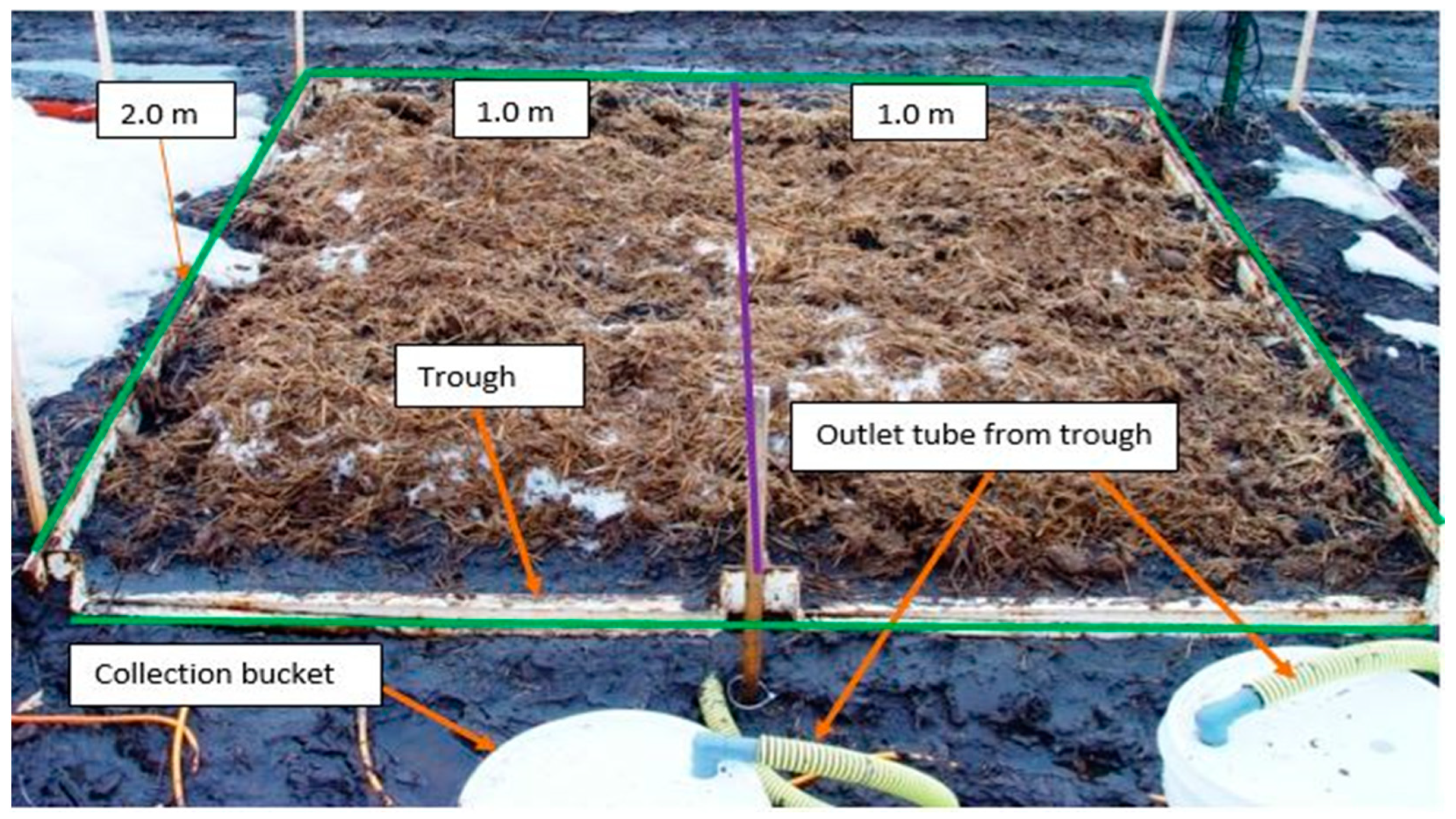
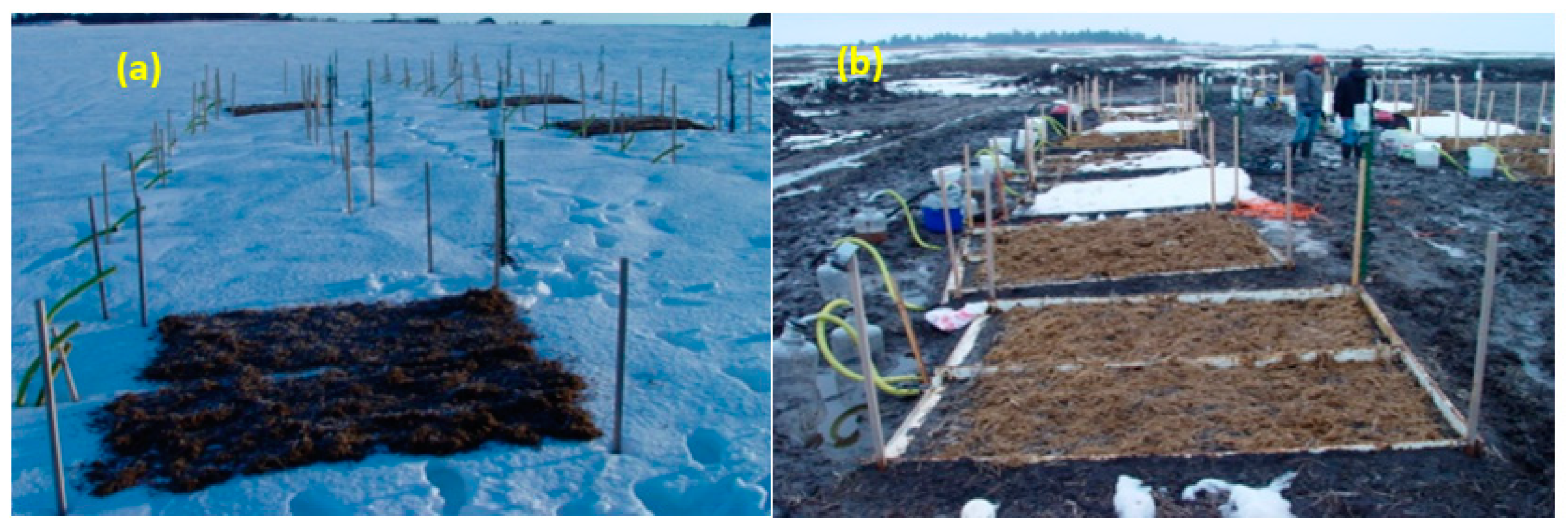
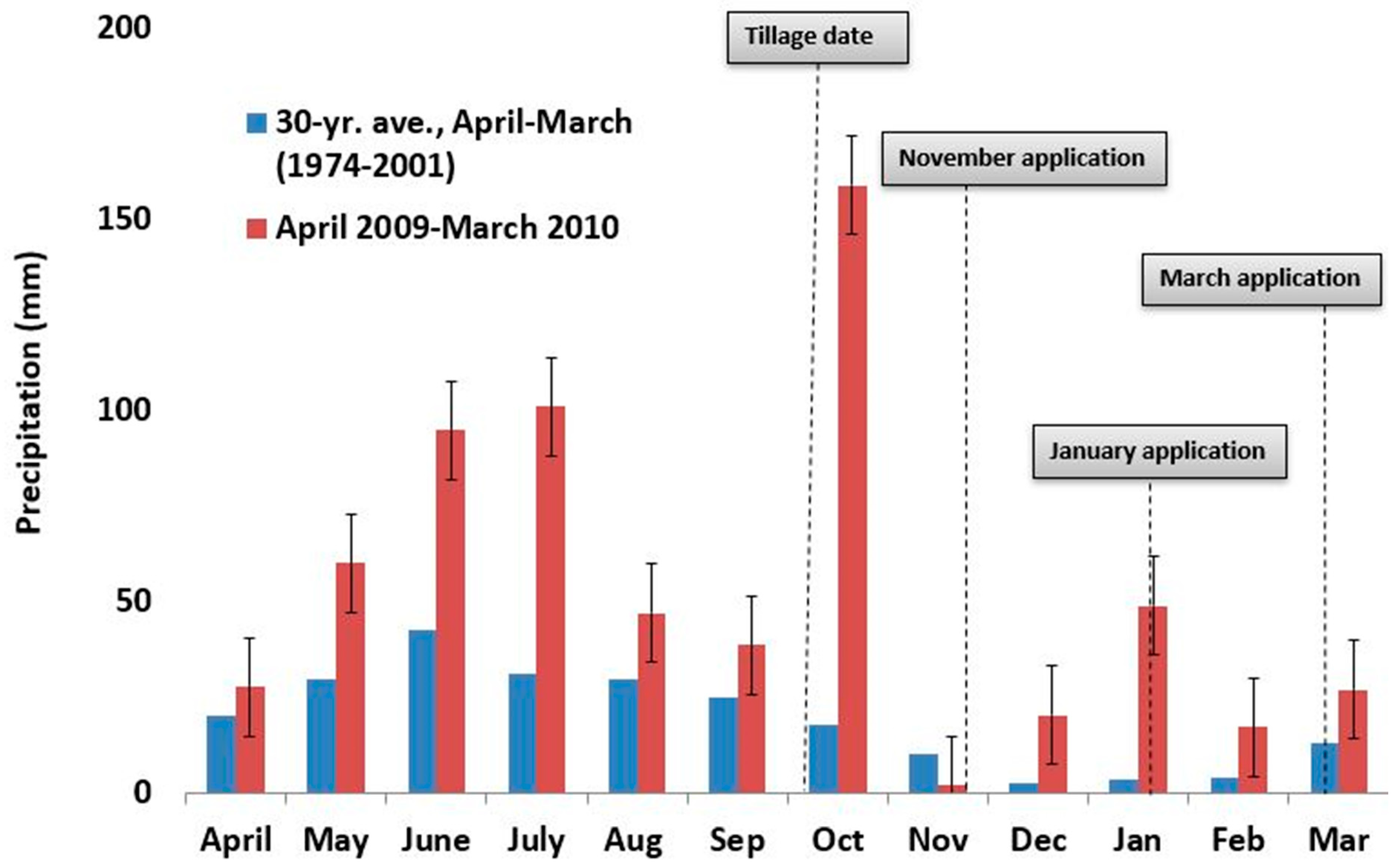
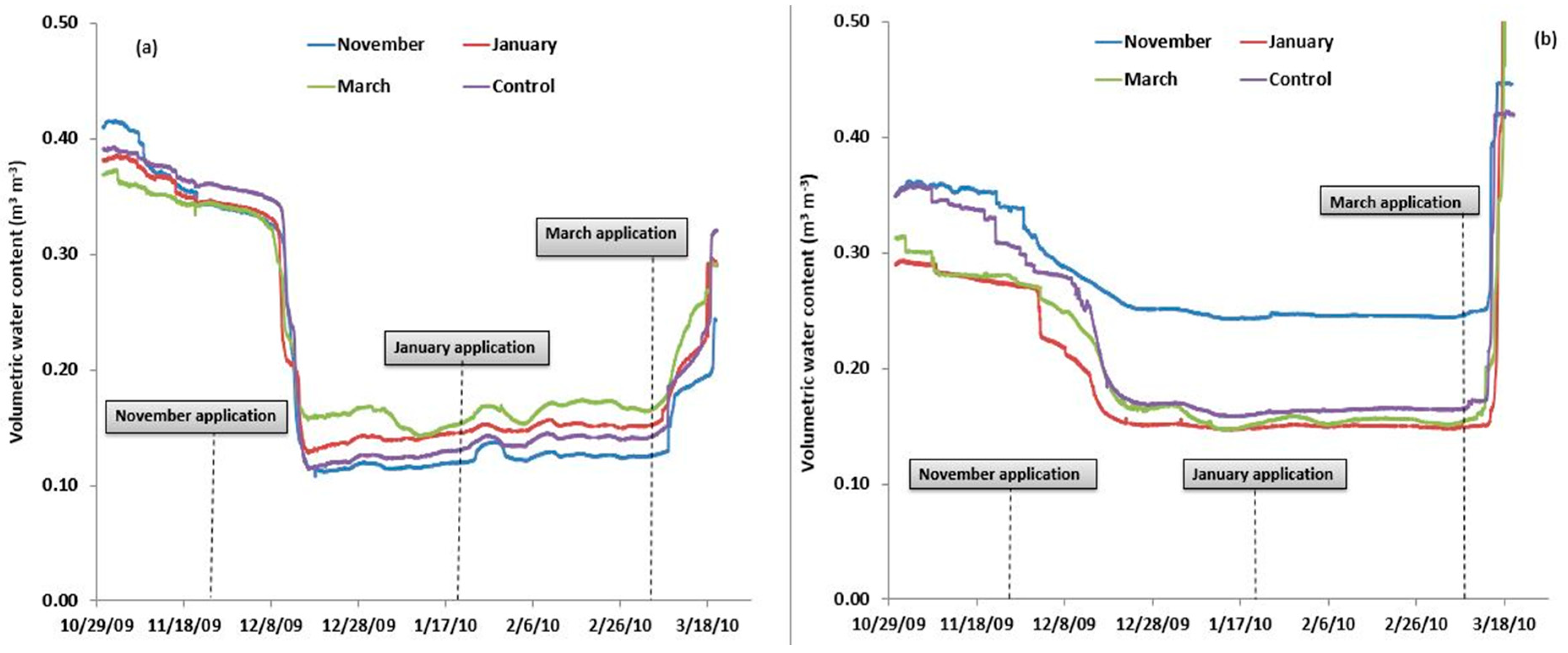
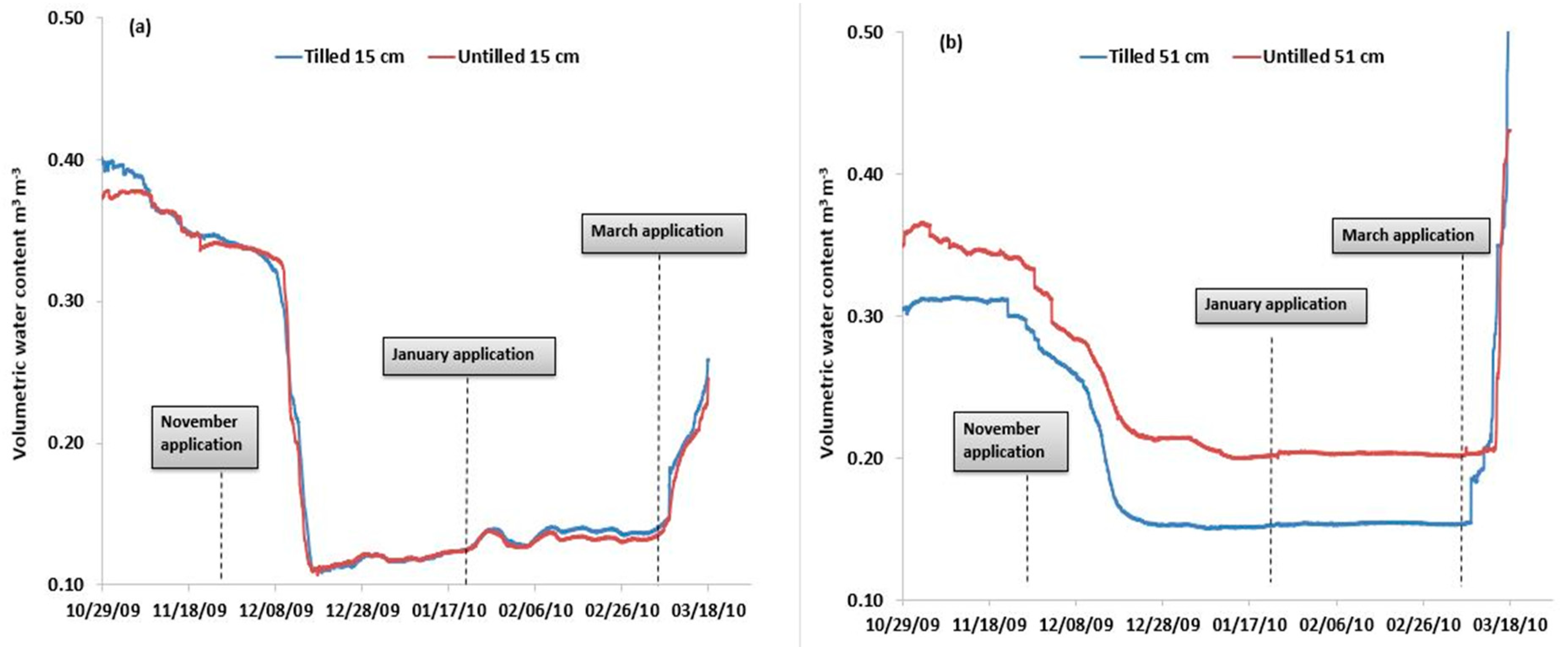

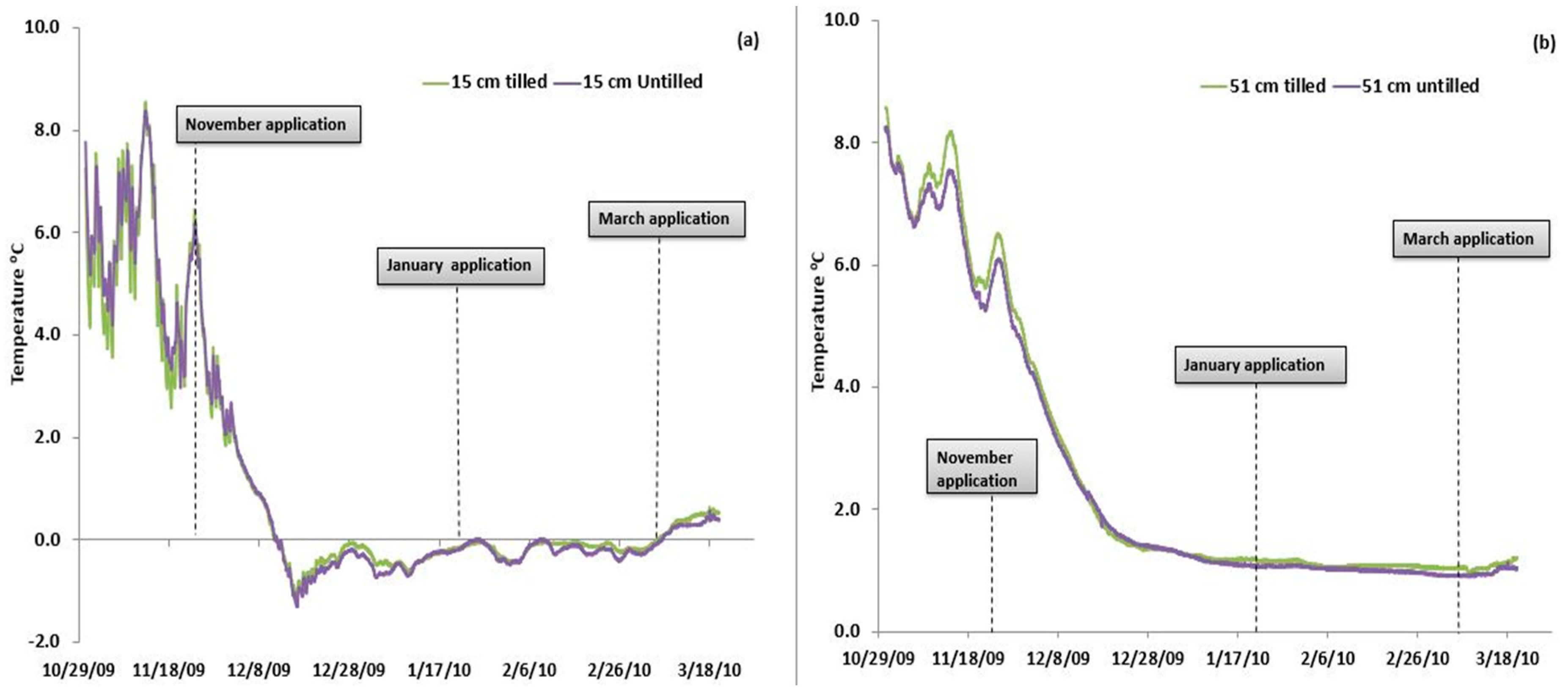

| Depth (cm) | Soil pH | Soil Nitrogen (ppm) | Soil Phosphorus (ppm) | Bulk Density (g cm−3) | Organic Matter (%) | CEC (meq/100 g soil) | SHG |
|---|---|---|---|---|---|---|---|
| 0–15 | 6.7 | 6 | 5 | 1.35 | 2 | 13.5 | B |
| 15–51 | 7.5 | 4 | 4.5 | 1.65 | 1.7 | 7 | B |
| Application Dates | Rate (Kg/2 m2) | † TDM (%) | ‡ NH4-N | § TN | ¶ TP |
|---|---|---|---|---|---|
| -----------------Kg ha−1----------------- | |||||
| November | 7.2 | 23.2 | 36 | 223 | 63 |
| January | 14 | 30 | 101 | 33 | |
| March | 23.8 | 61 | 351 | 56 | |
| Manure Application Dates | Average | Total Snow Accumulation since Previous Application (cm) | ||
|---|---|---|---|---|
| Soil Moisture (cm3) | Soil Temperature (°C) | Snow Depth (cm) | ||
| 28 November 2009 | 0.33 | 3 | 0.00 (0.00) ‡ | 0 |
| 28 January 2010 | 0.15 | −0.4 | 22.9 (2.3) | 58.5 |
| 4 March 2010 | 0.16 | −0.17 | 30.5 (3.0) | 35.6 |
| † ROC; 10 March 2010 | 0.22 | 0.47 | 15.2 (1.5) | 0 |
| Treatment Effect | Concentration in Runoff † | Load in Runoff ‡ | |||||||||||
|---|---|---|---|---|---|---|---|---|---|---|---|---|---|
| RO | NH4-N | NO3-N | TKN | TSS | TP | TDP | NH4-N | NO3-N | TKN | TSS | TP | TDP | |
| Orthogonal Contrast | Pr > F § | ||||||||||||
| Control vs. Manure | 0.84 | 0.01 # | 0.04 # | 0.01 # | 0.28 | 0.03 # | 0.01 # | 0.01 # | 0.11 | 0.04 # | 0.28 | 0.004 # | 0.001 # |
| Manure Application | mg L−1 | Kg ha−1 | |||||||||||
| No Manure Control (8) | 17.8a | 0.4a | 1.7a | 1.5a | 68.9a | 0.25a | 0.03a | 0.03a | 0.16a | 0.13a | 4.5a | 0.01a | 0.02a |
| Manured (20) | 16.5a | 3.3b | 2.6b | 17.5b | 106.0a | 2.8b | 2.2b | 0.33b | 0.23a | 1.6b | 7.4a | 0.27b | 0.21b |
| Tillage | mg L−1 | Kg ha−1 | |||||||||||
| Fall-Tilled (12) | 16.9a | 1.6a | 2.5a | 11.4a | 64.5a | 1.67a | 1.2a | 0.15a | 0.23a | 1.0a | 6.2a | 0.14a | 0.09a |
| Untilled (16) | 16.8a | 3.0b | 2.2a | 14.2a | 119.0a | 2.4a | 1.8a | 0.32b | 0.19a | 1.3a | 6.8a | 0.23a | 0.19b |
| Manure Timing | mg L−1 | Kg ha−1 | |||||||||||
| November (6) | 23.6a | 6.0a | 3.2a | 18.0ab | 39.5a | 3.5a | 2.9a | 0.72a | 0.38a | 2.17a | 4.64a | 0.42a | 0.35a |
| January (6) | 15.1b | 2.0b | 2.1a | 12.2a | 111.0ab | 2.2a | 1.8b | 0.17b | 0.14b | 1.00b | 7.00b | 0.19b | 0.15b |
| March (8) | 12.3b | 2.1b | 2.2a | 21.2b | 153.0b | 2.8a | 1.9b | 0.15b | 0.17b | 1.65ab | 9.68b | 0.21b | 0.14b |
| Source of Variation Without Control | ANOVA Pr > F | ||||||||||||
| Tillage [1]¶ | 0.52 | 0.02 # | 0.2 | 0.67 | 0.32 | 0.25 | 0.14 | 0.03 # | 0.14 | 0.78 | 0.17 | 0.52 | 0.2 |
| Manure Timing [2] | 0.06 | 0.01 # | 0.22 | 0.3 | 0.32 | 0.3 | 0.26 | 0.01 # | 0.02 # | 0.32 | 0.74 | 0.13 | 0.04 # |
| txm [2] | 0.74 | 0.04 # | 0.88 | 0.78 | 0.03 # | 0.39 | 0.14 | 0.04 # | 0.92 | 0.84 | 0.75 | 0.36 | 0.16 |
| MSE [10] | 54.3 | 0.77 | 2.2 | 74.3 | 77.7 | 1.5 | 1.1 | 0.02 | 0.03 | 1.2 | 89.7 | 0.02 | 0.01 |
| Treatment Effect | Concentration in Runoff † | Load in Runoff ‡ | |||||||||||
|---|---|---|---|---|---|---|---|---|---|---|---|---|---|
| RO | NH4-N | NO3-N | TKN | TSS | TP | TDP | NH4-N | NO3-N | TKN | TSS | TP | TDP | |
| mg L−1 | Kg ha−1 | ||||||||||||
| Fall tilled | |||||||||||||
| ontrol | 17.6 | 0.42 | 2.3 | 1.3 | 37.4 | 0.35 | 0.04 | 0.03 | 0.19 | 0.11 | 2.9 | 0.02 | 0.01 |
| November | 20.8 | 3.5 | 3.2 | 13.2 | 46.1 | 2 | 1.6 | 0.36 | 0.34 | 1.4 | 4.8 | 0.2 | 0.16 |
| January | 12.9 | 1.3 | 2 | 8.1 | 72.5 | 1.4 | 1.1 | 0.07 | 0.17 | 0.55 | 3.1 | 0.08 | 0.03 |
| March | 16.4 | 2.1 | 2.6 | 22.3 | 96.7 | 3 | 2.3 | 0.19 | 0.25 | 2 | 11.7 | 0.27 | 0.18 |
| Untilled | |||||||||||||
| Control | 17.9 | 0.43 | 1.1 | 1.7 | 100 | 0.15 | 0.02 | 0.04 | 0.14 | 0.16 | 6.2 | 0.01 | 0.01 |
| November | 25 | 7.2 | 3.3 | 20.4 | 36.1 | 4.2 | 3.6 | 0.9 | 0.4 | 2.6 | 4.6 | 0.5 | 0.44 |
| January | 16.3 | 2.4 | 2.1 | 14.2 | 130.2 | 2.6 | 2.2 | 0.22 | 0.14 | 1.2 | 9 | 0.23 | 0.16 |
| March | 8.3 | 2.2 | 1.8 | 20.1 | 209.3 | 2.6 | 1.6 | 0.13 | 0.09 | 1.3 | 7.7 | 0.16 | 0.12 |
| Manure Timing | RO | NH4-N | NO3-N | TKN | TSS | TP | TDP |
|---|---|---|---|---|---|---|---|
| Liters | Absolute Difference between Means Concentration (mg L−1) | ||||||
| Nov-Jan † | 8.47 # | 3.90 # | NS | NS | NS | NS | NS |
| Nov-Mar ‡ | 11.33 # | 3.84 # | NS | NS | 113.5 # | NS | NS |
| Jan–Mar § | NS | NS | NS | 9.04 # | NS | NS | NS |
| Liters | absolute difference between means runoff load (kg ha−1) | ||||||
| Nov–Jan | 8.47 # | 0.55 # | 0.20 # | 1.17 # | NS | 0.23 # | 0.19 # |
| Nov–Mar | 11.33 # | 0.56 # | 0.23 # | NS | NS | 0.20 # | 0.21 # |
| Jan–Mar | NS | NS | NS | NS | NS | NS | NS |
Publisher’s Note: MDPI stays neutral with regard to jurisdictional claims in published maps and institutional affiliations. |
© 2021 by the authors. Licensee MDPI, Basel, Switzerland. This article is an open access article distributed under the terms and conditions of the Creative Commons Attribution (CC BY) license (https://creativecommons.org/licenses/by/4.0/).
Share and Cite
Bhandari, A.B.; Gelderman, R.; German, D.; Todey, D. Manure Application Timing and Tillage Influence on Nutrient Loss from Snowmelt Runoff. Soil Syst. 2021, 5, 67. https://doi.org/10.3390/soilsystems5040067
Bhandari AB, Gelderman R, German D, Todey D. Manure Application Timing and Tillage Influence on Nutrient Loss from Snowmelt Runoff. Soil Systems. 2021; 5(4):67. https://doi.org/10.3390/soilsystems5040067
Chicago/Turabian StyleBhandari, Ammar B., Ronald Gelderman, David German, and Dennis Todey. 2021. "Manure Application Timing and Tillage Influence on Nutrient Loss from Snowmelt Runoff" Soil Systems 5, no. 4: 67. https://doi.org/10.3390/soilsystems5040067
APA StyleBhandari, A. B., Gelderman, R., German, D., & Todey, D. (2021). Manure Application Timing and Tillage Influence on Nutrient Loss from Snowmelt Runoff. Soil Systems, 5(4), 67. https://doi.org/10.3390/soilsystems5040067





